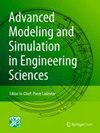基于pgd的空间分隔表示中增强的参数形状描述
IF 3.2
Q3 MECHANICS
Advanced Modeling and Simulation in Engineering Sciences
Pub Date : 2021-10-04
DOI:10.1186/s40323-021-00208-2
引用次数: 9
摘要
适当广义分解- pgd原理中的空间分离允许将高维问题作为一系列低维问题来解决。在我们以前的工作中,提出了不同的几何变换来处理复杂的形状和空间不可分离的域。分离表示的有效实现需要将域表示为涉及不同空间坐标的特征函数的乘积。在复杂形状的情况下,需要更复杂的几何变换来将复杂的物理域映射到执行计算的规则域。本文旨在提出一种非常有效的实现这种空间分离的途径。基于nurbs的几何表示(通常用于计算机辅助设计cad)被保留并与完全分离的表示相结合,以提高效率(通过完全分离的表示确保)和通用性(通过处理复杂的几何)。一些数值算例证明了所提方法的潜力。本文章由计算机程序翻译,如有差异,请以英文原文为准。
Enhanced parametric shape descriptions in PGD-based space separated representations
Space separation within the Proper Generalized Decomposition—PGD—rationale allows solving high dimensional problems as a sequence of lower dimensional ones. In our former works, different geometrical transformations were proposed for addressing complex shapes and spatially non-separable domains. Efficient implementation of separated representations needs expressing the domain as a product of characteristic functions involving the different space coordinates. In the case of complex shapes, more sophisticated geometrical transformations are needed to map the complex physical domain into a regular one where computations are performed. This paper aims at proposing a very efficient route for accomplishing such space separation. A NURBS-based geometry representation, usual in computer aided design—CAD—, is retained and combined with a fully separated representation for allying efficiency (ensured by the fully separated representations) and generality (by addressing complex geometries). Some numerical examples are considered to prove the potential of the proposed methodology.
求助全文
通过发布文献求助,成功后即可免费获取论文全文。
去求助
来源期刊

Advanced Modeling and Simulation in Engineering Sciences
Engineering-Engineering (miscellaneous)
CiteScore
6.80
自引率
0.00%
发文量
22
审稿时长
30 weeks
期刊介绍:
The research topics addressed by Advanced Modeling and Simulation in Engineering Sciences (AMSES) cover the vast domain of the advanced modeling and simulation of materials, processes and structures governed by the laws of mechanics. The emphasis is on advanced and innovative modeling approaches and numerical strategies. The main objective is to describe the actual physics of large mechanical systems with complicated geometries as accurately as possible using complex, highly nonlinear and coupled multiphysics and multiscale models, and then to carry out simulations with these complex models as rapidly as possible. In other words, this research revolves around efficient numerical modeling along with model verification and validation. Therefore, the corresponding papers deal with advanced modeling and simulation, efficient optimization, inverse analysis, data-driven computation and simulation-based control. These challenging issues require multidisciplinary efforts – particularly in modeling, numerical analysis and computer science – which are treated in this journal.
 求助内容:
求助内容: 应助结果提醒方式:
应助结果提醒方式:


